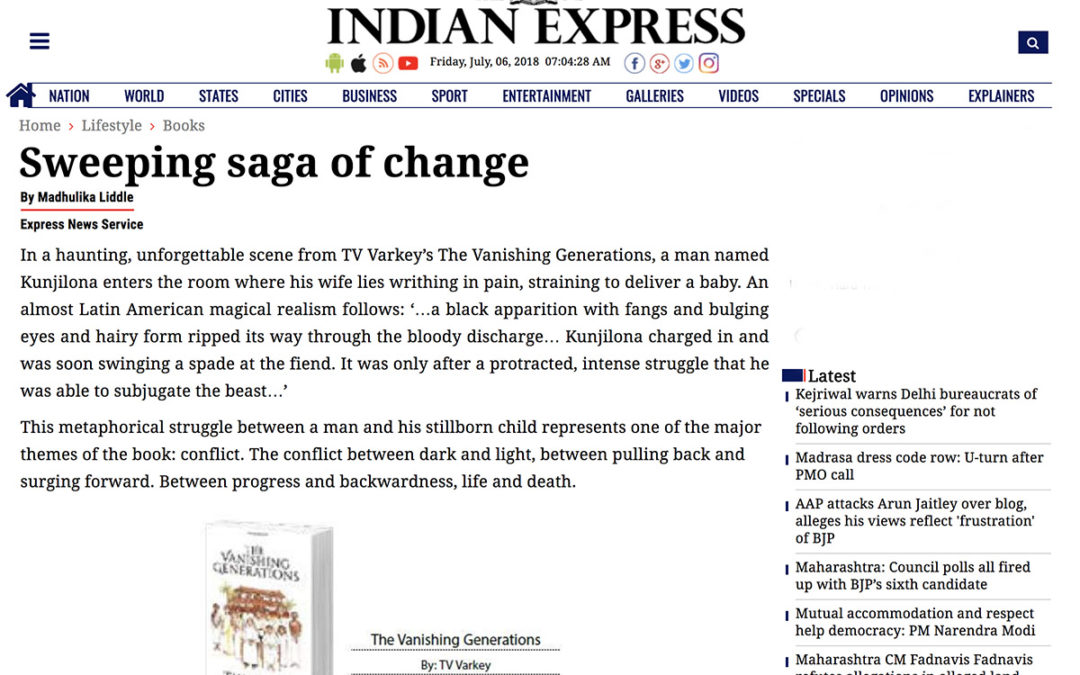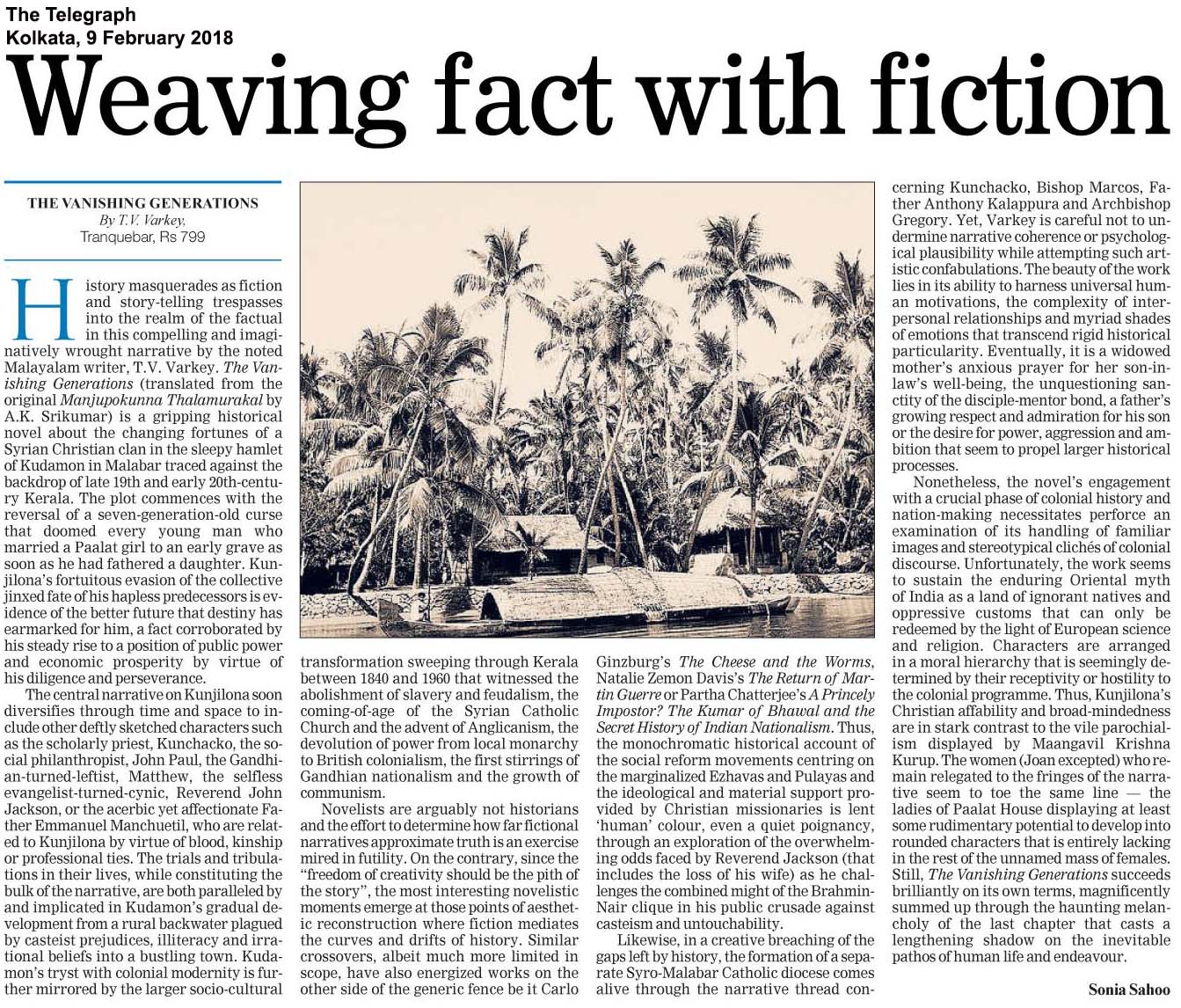Reviews
“T.V. Varkey's latest novel, The Vanishing Generations, is a tale of epic proportions about a family in Kerala and its brush with changes wrought by modernity on a traditional society.” The Sunday Guardian, 24 September 2017
“This book probes how historical events shape individuals and how people shape history. It is saga at once uplifting and also reflective of the tragedy of modern times.” The Asian Age, 20 September 2017
“This is an ambitious book. It is not easy to bring so many elements together in a believable, readable manner. Yet TV Varkey manages to do so, and impressively.” Indian Express Sunday Magazine, 14th October 2017
"The backdrop of this sweeping saga is Malabar—as it moves from being a backward society, torn apart by casteism, illiteracy and superstition, to a more progressive land. Varkey brings each period, its problems and its progress, as deftly to life as he does the lives of the family at Paalat House"Madhulika Liddle, Sunday Magazine, 14 October 2017
“In this novel, T.V. Varkey narrates not only the story of Syrian Christians during the past 125 years, but that of all communities in Kerala.” Mathrubhumi Newspaper.“A much-loved epic of Malayalam literature, T.V. Varkey’s magnum opus probes how historical events shape individuals and how people shape history.” DC Books News, 26 September 2017
"The Vanishing Generations succeeds brilliantly on its own terms magnificently summed up through the haunting melancholy of the last chapter that casts a lengthening shadow of the inevitable pathos of human life and endeavour-" critic Sonia Sahoo ends her lengthy article in the Telegraph"Kolkata, 9 February 2018
"A beautifully crafted mosaic of the lives of a family, that's also a sharp lens with which to explore the socio-political history of Kerala…"Shiny Varghese, Indian Express, Delhi - Published: February 17, 2018
T he Vanishing Generations’ is the story of a family well integrated with the history of the Syrian Catholic Church of Kerala. In this novel T. V. Varkey depicts impressively the relevant historical elements, which gives life to characters having great personal charisma and creative power. They represent the seven generations of the well-known Palattu family on a huge canvass and unfold the saga of a hundred and twenty-five years.
Kunjilona the protagonist of the first part comes to the Palattu as an adopted son-in-law, before the arrival of British Protestant Missionaries in Kerala. He was in fact deputed by time as the male members of the family were cursed with premature death. Miraculously the new bridegroom survives, and under his stewardship the family prospers along with the progressing Christian Churches and the movements of freedom struggles led by the Syrian Catholic population. As time passes before the eyes of Kunjilona, the community reaches the glorious period of Monsignor Kunchacko, the most intelligent Keralite of the last century. Here the narration gets a lively flow. And the novel too takes new course generating great interest in readers..
The struggle of different communities for their rights and privileges, and the quest for political freedom comes to picture by now. The leadership of the movement for social changes falls on Kunjilona’s grandson Francis. The next generation awakens with the ardent desire for the emancipation of the nation from the colonial rule. John Paul and Matthews represent this period. Their struggles later ends in the famous ‘liberation movement’ against the Communist rule in Kerala.
The lineage of the male members of the Palattu family extends from Kunjilona, the merchant who is endowed with business acumen. And he strengthens the financial foundation of the family. The next set of people beginning with Monsignor Kunchacko, Francis to John Paul and Matthews are known not for their wealthy inheritance, but as social reformers and revolutionaries.
Abraham gets only a very short space on the canvass as his powerful priest-brother eclipses him. Then Jesus, the only son of John Paul also ends up killed in an accident. Abraham, who deviates from the aristocratic moral strictness of the family to wayward pleasure seeking, represents the period when Christian community aspires for the cultivation of cardamom and tea in the high ranges in line with the British planters.
His aspirations take a deviation when his interests extend to the new arrival, the rubber plantation. Along with the economic and social changes, the Malayali vision of life, too, evolves. The transformation, which was not sparked in the dreams of Thandamma, Kunjilona’s mother-in-law, well reflects in the brilliant narration of Joan’s story. The whole historical evolution of the family through seven generations takes place with varied, distinctive characters ranging from Kunjilona to the innocent child Annie.
The rebirth of Kerala’s different communities makes the broad background of the novel. The renaissance of the untouchables takes place when the British Missionaries under the leadership of revolutionary Rev. John Jackson begin to work in Kudamon. He has to undergo great hardships to clear many hurdles. The novelist depicts the dark ages of the horrendous crimes against the downtrodden with care. The author’s insight and vision are well reflected in these pictures of the suffering of the poor, illiterate masses.
As we tread on the wider range of the novel we come across the vivid historical developments, metamorphosis of the communities, families and individuals. The chariot of advancement begins to roll when the first earthen road is constructed with the initiative of Kunjilona and blessings of Rev. John Jackson. Through the new opening the modern religious, cultural perspectives, literary aspirations and economic and social orders emerge into the village, Kudamon. The advent of new era brings the latest lifestyles and totally transforms the dreams and aspirations of the Malayali community. The tone and meaning of relationship of different societies also undergo changes - more positive and co-operative.
The continuous success of Rev. John Jackson’s agitation for equality and social justice for the weaker sections of the society, the untouchables and downtrodden, illustrate beautifully the undiminished human desire for change and growth. The novelist masterly portrays this part of the story with clear-cut humanistic vision, making the novel scintillating reading. However he doesn’t try to camouflage the narration with his wisdom and learning.
The novel begins in 1840s and the story of Syrian Christian movements for their independent Church is vividly is pictured. The hard work of Fr. Emmanuel Manchuvattil and the prayerful waiting for the arrival of the new Persian Bishop is of historical relevance. History and fiction fuse impressively giving the novel multidimensional artistic bearing and credibility.
A dazzling array of characters appears in this novel. They are the living representatives of hardworking members of Christian families. One could easily distinguish such a figure in Markose Mathai who belongs to a generation, which fought with wild elephants and herds of bison to create a new economic phase in Kerala. People like Kunjilona could never accept defeat and are ready to fight to the finish.
The concluding paragraph of the novel is the most touching picture of human destiny. Children play with skates made by craft paper, which carried the colourful paints of the portraits of the dead heroes of Palattu family. Like those multi-coloured skates the novel brings a spectrum of historical, social movements and variety of noteworthy characters representing the novelist’s philosophy of life. It doesn’t recreate a naïve superficial optimism, but grave and deeper meaning to the depiction of human condition and the futility of human endeavours.
This is a novel written after careful research and with a deep sense of history and the impact of social changes. Certainly long years of sweating are behind the novel like this. The narration is done with great felicity of style. There is the possibility of arranging a huge number of characters on the canvass, but the author has chosen only a few, which makes the reading easy. Suspense is kept unhampered as the incidents are systematically put in order as each sentence unravels a part of the story or innate quality of character.
The ‘Vanishing Generations” is definitely a modern classic in which history and changing vision of life of a people is amply portrayed. T V Varkey deserves thankful congratulations from the readers. An independent philosophical flavour of the author is well reflected in this novel. The reader will enjoy the result of long and untiring hard labour of writing. By Saloo Thaikkoodan (Library Magazine, November, 1992)
(Saloo Thaikkoodan is a journalist and a critic of modern Malayalam literature. He is a regular contributor of critical studies and represents the ambitious younger generation of writers in Kerala.)
Sweeping saga of change

I n a haunting, unforgettable scene from TV Varkey’s The Vanishing Generations, a man named Kunjilona enters the room where his wife lies writhing in pain, straining to deliver a baby. An almost Latin American magical realism follows: ‘…a black apparition with fangs and bulging eyes and hairy form ripped its way through the bloody discharge… Kunjilona charged in and was soon swinging a spade at the fiend. It was only after a protracted, intense struggle that he was able to subjugate the beast…’
This metaphorical struggle between a man and his stillborn child represents one of the major themes of the book: conflict. The conflict between dark and light, between pulling back and surging forward. Between progress and backwardness, life and death.
Set in a Malabar town named Kudamon, The Vanishing Generations (in its original Malayalam, Manjupokunna Thalamurakal) begins in about 1840, with the marriage of Kunjilona to the daughter of the Paalat House. This wedding is fraught with danger, because a curse that supposedly looms over Paalat House kills off any male who marries into the family—and no boys are ever born here, only girls.

However, Kunjilona changes not just the destiny of this family, but his own, and that of the town of Kudamon. Through his perseverance, his hard work, his vision and ambition, Kunjilona succeeds in bringing about changes that Kudamon could not have dreamt of. It is not only Kunjilona, but his descendants who change Kudamon: his son, the priest Rev Kunchacko; Kunchacko’s nephew, Francis; and Francis’s son, Mathew, who becomes first a Gandhian and then a revolutionary, veering sharply to the left.
The backdrop of this sweeping saga is Malabar—as it moves from being a backward society, torn apart by casteism, illiteracy and superstition, to a more progressive land. Varkey brings each period, its problems and its progress, as deftly to life as he does the lives of the family at Paalat House.
On the one hand, the Malabar Syrian Catholic church strives to free itself of Papal authority; on the other, Kunjilona and his missionary friend, John Jackson, try to improve the lot of the Ezhavas and the other lower castes. Kunchacko carries on the fight, as do his descendants, in the process binding Kudamon to the rest of Malabar, to the rest of India, and to the world.
Against this backdrop is the story of the Paalat household: their trials and triumphs, their successes and failures. How they change and how the changing world affects them, and how they are instrumental in bringing about so many of those changes. Their relationships, their dreams, their strengths and weaknesses.
It is an ambitious book: it is not easy to bring so many elements together in a believable, readable manner. Yet TV Varkey manages to do so, and impressively. At times, the narrative does become impersonal, delving too deep and dwelling too long on the overall picture—the politics and the socio-economic scenario—but that is a minor irritant in a book that is otherwise memorable.
http://www.newindianexpress.com/lifestyle/books/2017/oct/14/sweeping-saga-of-change-1672563.htmlBy Madhulika Liddle ( 14th October 2017 | 10:00 PM )
Express News Service
Home and Beyond
T his metaphorical struggle between a man and his stillborn child represents one of the major themes of the book: conflict. The conflict between dark and light, between pulling back and surging forward. Between progress and backwardness, life and death.

The Vanishing Generations
T V Varkey (Translation by AK Srikumar)
Tranquebar< br>
634 pages
Rs 799
We vouchsafe a Syrian Catholic church that will reflect the uniqueness of Malabar, so that we may create a church incorporating our pure ancient philosophies and guru-shishya traditions… A community that does not foster its native spirit will not be able to survive.” These words of Reverend Kunchacko in The Vanishing Generations (Manjupokunna Thalamurakal) sum up what its author, TV Varkey, says in its 620 pages. One is never far from either the sense of the land or native pride in this novel, which has been translated from Malayalam into English by AK Srikumar.
Varkey’s novel, placed in the fictional town of Kudamon, is a quilted narrative of southern Kerala through its social, cultural and political history. The story maps the evolution of a society that was at its syncretic best, yet not without its failings — slavery and caste oppression were acceptable and feudalism was a way of life. Kudamon, an obscure village, balloons into a trader’s town, and also a cultural hub for writers. Varkey’s Manjupokunna Thalamurakal (The Vanishing Generations) assumes a wider arc, presenting the growth of the Syrian Catholic church, changes in Hindu communities, especially the Namboodiri Brahmins, and the rise of a communist government in independent Kerala. Spanning nearly a century, from the 1850s to the 1960s, the story circuits the Syrian Catholic Paalat family, across seven generations.
We enter the story with the protagonist, Kunjilona, who takes on a generational curse that tails Kudamon’s Paalat family — men who marry girls from the Paalat family give birth to a daughter, and die soon after. However Kunjilona survives, and creates for the family a firm foundation of liberal thinking, enterprise and audacious inquiry. With an entrepreneurial bent, he opens Paalat Stores, shifting from farming as their traditional occupation. The decadence of the caste system, though, is seen in every quotidian ritual, from walking on the streets to the right to education. While Kunjilona doesn’t buy into it, he knows how to navigate his way around the social constructs. At the store, he welcomes the upper caste Brahmin and is correct with the lower caste Ezhavas and Pulayas.
The entry of Rev John Jackson and his wife Margaret into this undiscovered village brings with it ideas of a free society and access to the outside world — not only with roads, but also education that goes beyond Sanskrit texts. Running parallel to this is the progress of the local Syrian Catholic Church, which becomes the pivot around which education, trade and egalitarian ideals take shape.
Father Emmanuel Manchuetil, the flag bearer of the church, has the indefatigable energy to defy the supremacy of Rome and appoints Kunjilona’s son, Kunchacko, to become his successor — Rev Kunchacko, conversant with Sanskrit shlokas and the law of the land, can even arrange for goons if required. He is made the Vicar General of the church, and, like his father, is both provocateur and priest to the town. The church soon takes on the onus of health and educational needs, bringing business and community together. Politics is not seen as party-led as much as it is about helping people evolve. Rev Kunchacko campaigns for the education of the girl child, widow marriages, and even starts a newspaper to raise awareness about social discriminations. Kunjilona’s other son, Abraham, takes on the family business, and expands into tea plantations and rubber estates.
And with the entry of two further generations, Francis and John Paul, Kudamon finds itself inside a Renaissance vortex, marked by its people’s intellectual, economic and political sagacity. A Paalat Press is also established soon, and a new world opens up for Kudamon. It begins to participate in the larger narrative of the country, engaging with writers and poets such as CV Raman Pillai and VC Balakrishna Panicker, and freedom fighters such as Gopal Krishna Gokhale and Mahatma Gandhi. The Vaikom Satyagraha, a movement against untouchability, features too. With the passage of time, Kudamon sees government jobs increase and petrol-driven vehicles enter the town, and, one sees how the church grows into a dictatorial institution that proclaims damnation on anyone who goes against them. The irony lies in John Paul’s breaking away from the church in the end, closing the Paalat family’s chapter that began with his great-grandfather, Kunjilona.
The women who stand by their men — Mariamma, Kunjilona’s wife, her mother, Thaandamma, or Joan, mother to Annie, the seventh generation, are stoic about everything life throws at them. When the novel begins, we see lower caste women are bare-breasted and walk in front of processions in temples with naked chests. The saying that “when the hen crows, the world will end”, is symptomatic of what an entire society feels. When feisty Joan comes into the frame, she says, “I don’t want to marry, again. When I need a man, I will hire one…” The translation by Srikumar is impeccable. But, all the characters are unidimensional, with very little shading in them. Like in all good literature, the story, ultimately, is about human relationships and the society it shapes. However, the book closes on a Tolstoian note, where one realizes: “The only absolute knowledge attainable by man is that life is meaningless”. For all the latest Lifestyle News, download Indian Express App
Weaving fact with fiction

H istory masquerades as fiction and story-telling trespasses into the realm of the factual in this compelling and imaginatively wrought narrative by the noted Malayalam writer, T.V. Varkey. The Vanishing Generations (translated from the original Manjupokunna Thalamurakal by A.K. Srikumar) is a gripping historical novel about the changing fortunes of a Syrian Christian clan in the sleepy hamlet of Kudamon in Malabar traced against the backdrop of late 19th and early 20th-century Kerala. The plot commences with the reversal of a seven-generation-old curse that doomed every young man who married a Paalat girl to an early grave as soon as he had fathered a daughter. Kunjilona’s fortuitous evasion of the collective jinxed fate of his hapless predecessors is evidence of the better future that destiny has earmarked for him, a fact corroborated by his steady rise to a position of public power and economic prosperity by virtue of his diligence and perseverance.
https://www.telegraphindia.com/opinion/weaving-fact-with-fiction-207116![writer [1]](http://tvvarkey.in/wp-content/uploads/2018/08/writer-1.png)